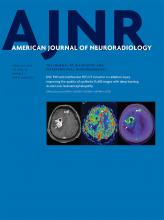Index by author
Bendszus, M.
- NeurointerventionYou have accessClinical Outcome after Thrombectomy in Patients with Stroke with Premorbid Modified Rankin Scale Scores of 3 and 4: A Cohort Study with 136 PatientsF. Seker, J. Pfaff, S. Schönenberger, C. Herweh, S. Nagel, P.A. Ringleb, M. Bendszus and M.A. MöhlenbruchAmerican Journal of Neuroradiology February 2019, 40 (2) 283-286; DOI: https://doi.org/10.3174/ajnr.A5920
Benninger, K.L.
- PediatricsOpen AccessMR Imaging Scoring System for White Matter Injury after Deep Medullary Vein Thrombosis and Infarction in NeonatesK.L. Benninger, N.L. Maitre, L. Ruess and J.A. RusinAmerican Journal of Neuroradiology February 2019, 40 (2) 347-352; DOI: https://doi.org/10.3174/ajnr.A5940
Benson, J.C.
- FELLOWS' JOURNAL CLUBAdult BrainOpen AccessAcute Toxic Leukoencephalopathy: Etiologies, Imaging Findings, and Outcomes in 101 PatientsC. Özütemiz, S.K. Roshan, N.J. Kroll, J.C. Benson, J.B. Rykken, M.C. Oswood, L. Zhang and A.M. McKinneyAmerican Journal of Neuroradiology February 2019, 40 (2) 267-275; DOI: https://doi.org/10.3174/ajnr.A5947
Of 101 included patients, the 4 subgroups of >6 were the following: chemotherapy (n = 35), opiates (n = 19), acute hepatic encephalopathy (n = 14), and immunosuppressants (n = 11). Other causes (n = 22 total) notably included carbon monoxide (n = 3) metronidazole (n = 2), and uremia (n = 1). Acute hepatic/hyperammonemic encephalopathy clinically resolved in 36%, with severe outcomes in 23% (coma or death, 9/16 deaths from fludarabine). Notable laboratory results were elevated CSF myelin basic protein levels in 8/9 patients and serum blood urea nitrogen levels in 24/91. Acute toxic leukoencephalopathy is an imaging appearance that can arise from various etiologies, with potentially reversible reduced diffusion predominately affecting the periventricular WM. Given the shared DWI appearance among this heterogeneous array of etiologies, their outcomes may differ. Thus, the neurologic symptoms completely resolved in 36%, while severe outcomes occurred in 23%. The clinical outcome was most severe with chemotherapy-related ATL.
Ber, R.
- PediatricsYou have accessVolumetric MRI Study of the Brain in Fetuses with Intrauterine Cytomegalovirus Infection and Its Correlation to Neurodevelopmental OutcomeA. Grinberg, E. Katorza, D. Hoffman, R. Ber, A. Mayer and S. LipitzAmerican Journal of Neuroradiology February 2019, 40 (2) 353-358; DOI: https://doi.org/10.3174/ajnr.A5948
Blanken, L.M.E.
- PediatricsOpen AccessCavum Septum Pellucidum in the General Pediatric Population and Its Relation to Surrounding Brain Structure Volumes, Cognitive Function, and Emotional or Behavioral ProblemsM.H.G. Dremmen, R.H. Bouhuis, L.M.E. Blanken, R.L. Muetzel, M.W. Vernooij, H.E. Marroun, V.W.V. Jaddoe, F.C. Verhulst, H. Tiemeier and T. WhiteAmerican Journal of Neuroradiology February 2019, 40 (2) 340-346; DOI: https://doi.org/10.3174/ajnr.A5939
Blessing, E.
- Adult BrainYou have accessSexual Dimorphism and Hemispheric Asymmetry of Hippocampal Volumetric Integrity in Normal Aging and Alzheimer DiseaseB.A. Ardekani, S.A. Hadid, E. Blessing and A.H. BachmanAmerican Journal of Neuroradiology February 2019, 40 (2) 276-282; DOI: https://doi.org/10.3174/ajnr.A5943
Bliss, T.
- Review ArticleOpen AccessA Review of Magnetic Particle Imaging and Perspectives on NeuroimagingL.C. Wu, Y. Zhang, G. Steinberg, H. Qu, S. Huang, M. Cheng, T. Bliss, F. Du, J. Rao, G. Song, L. Pisani, T. Doyle, S. Conolly, K. Krishnan, G. Grant and M. WintermarkAmerican Journal of Neuroradiology February 2019, 40 (2) 206-212; DOI: https://doi.org/10.3174/ajnr.A5896
Botto, A.
- PediatricsYou have accessBrain DSC MR Perfusion in Children: A Clinical Feasibility Study Using Different Technical Standards of Contrast AdministrationS. Gaudino, M. Martucci, A. Botto, E. Ruberto, E. Leone, A. Infante, A. Ramaglia, M. Caldarelli, P. Frassanito, F.M. Triulzi and C. ColosimoAmerican Journal of Neuroradiology February 2019, 40 (2) 359-365; DOI: https://doi.org/10.3174/ajnr.A5954
Bouhuis, R.H.
- PediatricsOpen AccessCavum Septum Pellucidum in the General Pediatric Population and Its Relation to Surrounding Brain Structure Volumes, Cognitive Function, and Emotional or Behavioral ProblemsM.H.G. Dremmen, R.H. Bouhuis, L.M.E. Blanken, R.L. Muetzel, M.W. Vernooij, H.E. Marroun, V.W.V. Jaddoe, F.C. Verhulst, H. Tiemeier and T. WhiteAmerican Journal of Neuroradiology February 2019, 40 (2) 340-346; DOI: https://doi.org/10.3174/ajnr.A5939
Boutet, A.
- FELLOWS' JOURNAL CLUBAdult BrainYou have accessA Deep Learning–Based Approach to Reduce Rescan and Recall Rates in Clinical MRI ExaminationsA. Sreekumari, D. Shanbhag, D. Yeo, T. Foo, J. Pilitsis, J. Polzin, U. Patil, A. Coblentz, A. Kapadia, J. Khinda, A. Boutet, J. Port and I. HancuAmerican Journal of Neuroradiology February 2019, 40 (2) 217-223; DOI: https://doi.org/10.3174/ajnr.A5926
The purpose of this study was to develop a fast, automated method for assessing rescan need in motion-corrupted brain series. A deep learning–based approach was developed, outputting a probability for a series to be clinically useful. Comparison of this per-series probability with a threshold, which can depend on scan indication and reading radiologist, determines whether a series needs to be rescanned. The deep learning classification performance was compared with that of 4 technologists and 5 radiologists in 49 test series with low and moderate motion artifacts. Fast, automated deep learning–based image-quality rating can decrease rescan and recall rates, while rendering them technologist-independent. It was estimated that decreasing rescans and recalls from the technologists' values to the values of deep learning could save hospitals $24,000/scanner/year.








